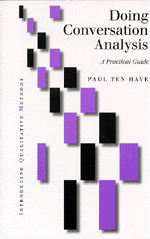

![]()
![]()

Instructional resources like this book typically have two problems to face. The first is the degree to which the instructions given are actually adequate to the problem of analysis facing researchers. The second is the extent to which one should deal with the internecine disputes that plague not only C.A. and ethnomethodology, but other sociological areas as well, given that the methodological problem of Œhow to do it‚ rather depends on positions taken within such disputes. Ten Have handles both of these problems rather well.
He introduces his themes by taking, roughly speaking, a historical perspective on C.A., identifying exemplary studies undertaken by Sacks and Schegloff, singly and jointly, and discussing them at length, and then by examining the commitments to Œevidence‚ entailed. He makes the initial point, developed later in the book, that the history of C.A. sees divisions of various kinds arising, including that between Œordinary‚ conversation and institutional talk‚ and between Œpure‚ and Œapplied‚ C.A. Such distinctions are at the root of many debates within the broad ethnomethodological community and the author refers to each of them in turn. It would be unfair to criticise a book of this nature for taking an uncritical line on some perspectives within C.A., and Ten Have for the most part is studiously neutral regarding his position on disputes concerning, for instance, the merits of the Œinstitutional talk‚, whilst describing what those disputes consist in.
C.A. is of course, a Œdata driven‚ sociology and, as such, the core of the book lies in the issues of collecting data, transcribing it, and the analytic work to be done with it. Much of what is said here is straightforward and extensive examples taken from existing literature are provided throughout. Descriptions of how issues such as Œturn-taking‚, Œsequencing‚, Œrepair work‚ and Œrecipient design‚ are all dealt with in this way. The subsequent elaboration of various issues surrounding the methodological consequences of stances such as that of Heritage on ŒInstitutional Interaction‚ exemplifies Ten Have‚s thorough and even-handed approach.
This carries through into a lengthy discussion of different ways in which C.A. can be Œapplied‚, and here there is a limited discussion of the relationship between ethnomethodology and C.A. ŒApplied‚ C.A. includes studies of Œimpaired‚ communication and, disappointingly briefly, human computer interaction. Much of the work he cites in this context owes most to the ethnomethodological Œstudies of work‚ programme rather than C.A., and even work such as that of Heath and Luff which originates in the C.A. paradigm is far removed from C.A.s Œformal‚ concerns. The absence of a turn-taking mechanism in studies which implicate glances, gazes, Œoverhearings‚ and other gestural features is more fundamental than Ten Have seems to believe. The move to the study of Œembodied‚ communication arguably entails methodological choices that are radically distinct from those entailed in C.A. Nevertheless, this is a minor criticism in the context of the overall purpose of the book. Equally, although video analysis is somewhat cursorily dealt with here, the author is clear that this is because another book in the series will be on that topic.
Overall, the book will be useful to new researchers interested in C.A., whether Œpure‚ or Œapplied‚. It will provide enough practical detail and analytic insight to help any new researcher in the field and can be recommended for that purpose. Older hands may also find the way in which various positions are stepped through fairly interesting, though they will have to look elsewhere for a principled argument concerning their relative merits.
David Randall
Manchester Metropolitan University
